动物们是如何在“雪球地球”中生存下来的?
动物们是如何在“雪球地球”中生存下来的?
As humans heat up the Earth with greenhouse gases, we're recreating an ancient climate unlike anything our species has ever seen. This is drawing more attention to the history of Earth's climates, especially warm periods like the Pliocene Epoch, which many scientists consider a model for where we're headed.
随着人类用温室气体使地球升温,我们正在重建一种我们从未见过的远古气候。这引起了人们对地球气候历史的更多关注,尤其是像上新世这样的温暖时期,许多科学家认为上新世是我们前进方向的一个模型。
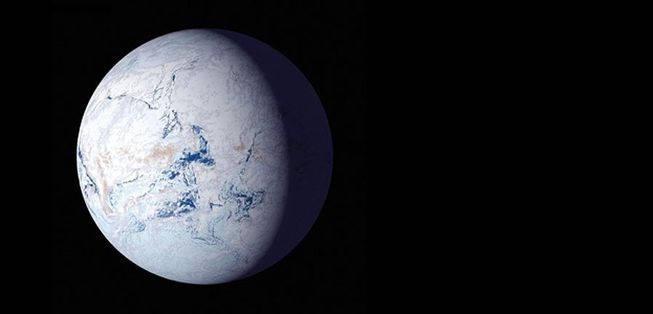
An artist's impression of 'Snowball Earth.' (Image: NASA)
At the same time, though, researchers are also shedding new light on other, very different periods in Earth's past. These too can reveal key details about our planet, and even ourselves, despite bearing little resemblance to the world we know today.
然而,与此同时,研究人员也对地球历史上其他非常不同的时期进行了新的研究。这些也可以揭示我们的星球,甚至我们自己的关键细节,尽管与我们今天所知的世界几乎没有相似之处。
One such period is the the Cryogenian, which lasted from about 720 million to 635 million years ago. That's when Earth experienced the most extreme ice age in its history, including a global freeze known as "Snowball Earth."
其中一个时期是低温期,从大约7.2亿年前持续到6.35亿年前。那时,地球经历了其历史上最极端的冰河时代,包括被称为“雪球地球”的全球冻结。
Somehow, though, it was also when the first signs of complex animals appeared in the fossil record, left by creatures who set the stage for a golden age of animal life that continues today. In a new study, researchers examined the chemistry of Cryogenian rocks to learn more about this unfamiliar world — including why it was able to not only support animal life, but also seemingly launch it to new heights.
然而,也正是在那个时候,复杂动物的最初迹象出现在化石记录中,这些生物为延续至今的动物生命的黄金时代奠定了基础。在一项新的研究中,研究人员检测了低温岩石的化学成分,以进一步了解这个陌生的世界——包括为什么它不仅能够支持动物生命,而且似乎还能把它推向新的高度。
Let it snow
下雪
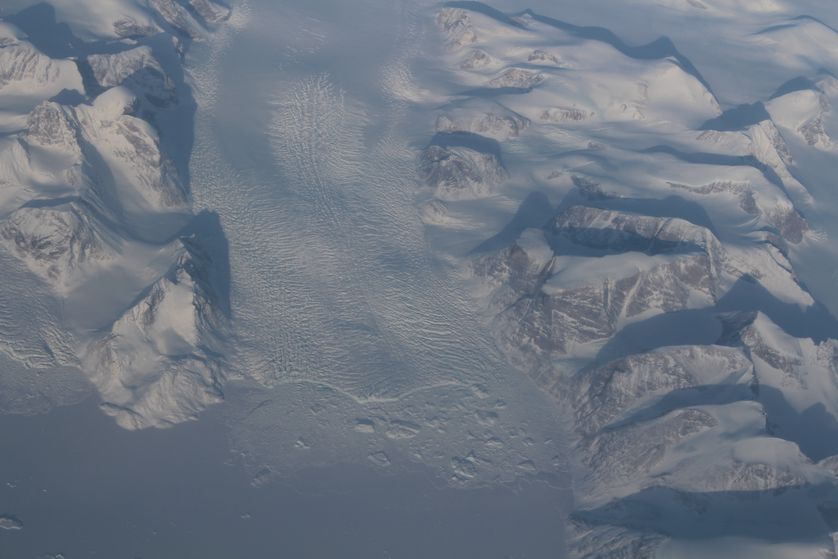
Ice sheets now cover parts of Greenland and Antarctica, but during the Cryogenian Period, they may have covered vast swaths of Earth's surface. (Photo: Laura Tenenbaum [CC BY 2.0]/NASA)
The planet's surface became fully or almost fully frozen during the Cryogenian, with enormous ice sheets stretching down to the tropics. (There is still some debate about the extent of this freeze, though.) Most landmasses were united in the supercontinent Rodinia, but thanks to the global glacier, Earth's entire surface may have been effectively solid. The average surface temperature probably didn't go far above freezing, and some research suggests temperatures were much colder, possibly falling below minus 50 degrees Celsius (minus 58 Fahrenheit).
在低温时代,地球表面完全或几乎完全冻结,巨大的冰原一直延伸到热带地区。(不过,对于冻结的程度仍有一些争议。)大部分的大陆块都在超级大陆罗迪尼亚统一,但是由于全球冰川的作用,地球的整个表面可能已经变得非常坚固。地球表面的平均温度可能不会超过冰点很多,一些研究表明,温度要低得多,可能会降到零下50摄氏度(零下58华氏度)以下。
There were actually two big freezes during the Cryogenian, known as the Sturtian and Marinoan glaciations, separated by a brief intermission of heat, melting ice and erupting volcanoes. This was a wild time for our planet, which was see-sawing between extremes of ice and fire, but also an important one. That's because, despite seeming like a terrible time to be alive, the Cryogenian Period apparently helped spark the dawn of complex animals — including our own ancestors.
事实上,在冰川期有两次大的冰期,被称为斯图尔特期和马里诺期冰川期,其间有短暂的热间歇、冰的融化和火山的喷发。对我们的星球来说,这是一个疯狂的时代,在极端的冰和火之间摇摆不定,但也是一个重要的时刻。这是因为,尽管低温时代对人类来说似乎是一个可怕的时代,但它显然帮助激发了复杂动物的黎明——包括我们自己的祖先。
If you're wondering how animals survived on Snowball Earth, you're not alone. It would've been incredibly difficult for animals to survive on the ice sheets, but also in the seawater below, since a global coating of ice would severely hinder the oceans' ability to absorb oxygen. Scientists have long puzzled over this apparent paradox, but the new study, published this week in the Proceedings of the National Academy of Sciences, is the latest in a growing body of research that's finally offering answers.
如果你想知道动物是如何在雪球地球上生存下来的,你并不孤单。对动物来说,要在冰原上以及下面的海水中生存是非常困难的,因为全球覆盖的冰层会严重阻碍海洋吸收氧气的能力。长期以来,科学家们一直对这一明显的悖论感到困惑,但本周发表在《美国国家科学院院刊》上的这项新研究,是越来越多最终给出答案的研究中的最新成果。
Explosion of animal life
动物生命的大爆发
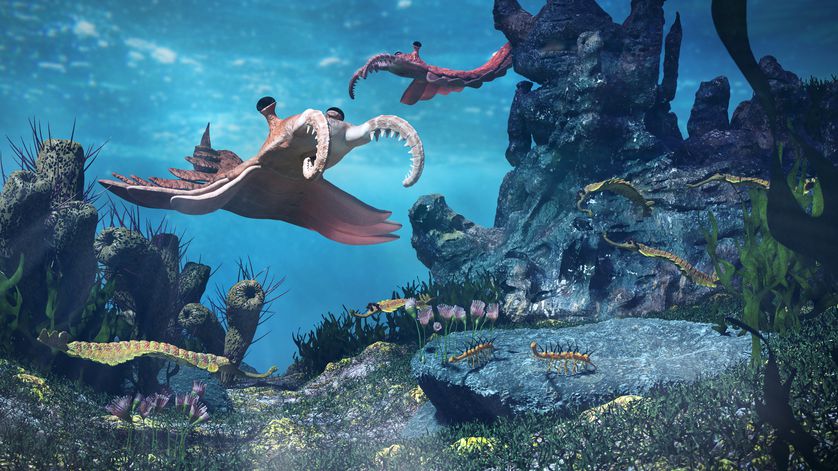
The Cambrian Explosion was a huge turning point in Earth's history, thanks to an evolutionary boom that yielded increasingly big and complex animals. (Illustration: Dotted Yeti/Shutterstock)
Life on Earth began long before the Cryogenian, but it was mostly single-celled microbes. Even when multicellular animals did arise, they were simple, often stationary creatures, calmly filtering seawater or grazing on mats of microbes. These early animals did not yet have innovations like eyes, legs, jaws or claws, and in a world without predators, they didn't really need them.
地球上的生命早在低温时代之前就开始了,但大多数是单细胞微生物。即使多细胞动物真的出现了,它们也是简单的,通常是静止的生物,平静地过滤海水,或以微生物为食。这些早期的动物还没有像眼睛、腿、下巴或爪子这样的创新,在一个没有捕食者的世界里,它们并不真正需要这些。
According to the new study, though, even a frozen ocean might not have been as inhospitable to these ancient organisms as we tend to think.
然而,根据这项新研究,即使是冰冻的海洋也不会像我们通常认为的那样不适合这些古代生物生存。
A 'glacial oxygen pump'
“冰川氧气泵”
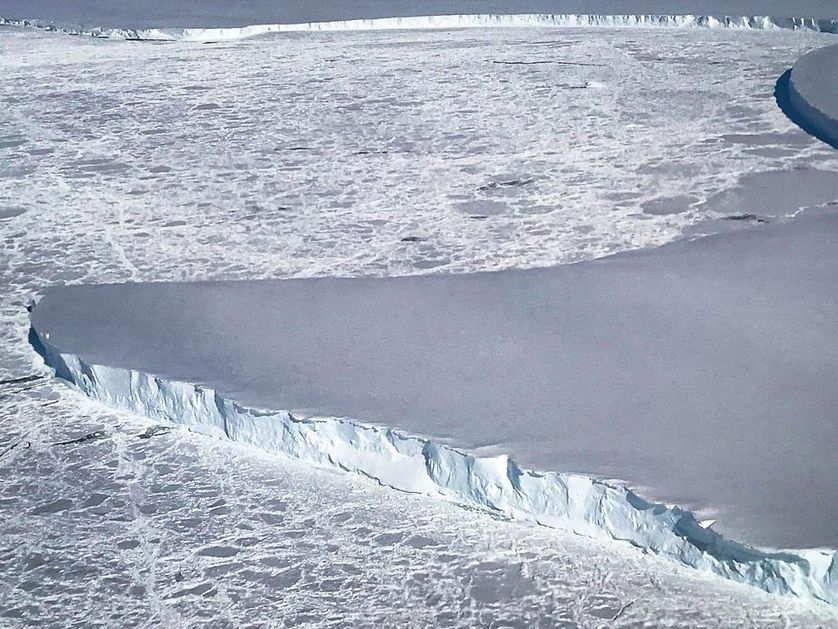
The edge of the Venable Ice Shelf juts into the ocean between two peninsulas from Antarctica. (Photo: Operation IceBridge/NASA Goddard Space Flight Center [CC BY 2.0]/Flickr)
The study's authors looked at iron-rich rocks known as ironstones from Australia, Namibia and California, all of which date back to the Sturtian glaciation. These rocks were deposited in a range of glacial environments, the researchers found, providing a well-rounded picture of what marine conditions were like at the time.
该研究的作者观察了澳大利亚、纳米比亚和加利福尼亚的富含铁的岩石,这些岩石都可以追溯到斯特尔特冰川时代。研究人员发现,这些岩石是在一系列冰川环境中沉积下来的,为当时的海洋环境提供了一幅完整的图像。
Glaciers are created by snow, which slowly becomes compressed into glacier ice as it accumulates. The snow holds air bubbles, including oxygen, that become trapped in the ice. Those bubbles move down through the ice over time, eventually escaping with meltwater from the underside of the glacier. In certain places, that might have provided just enough oxygen to help early marine animals survive Snowball Earth.
冰川是由雪形成的,随着雪的累积,它慢慢地被压缩成冰川冰。雪中含有气泡,包括氧气,气泡被困在冰中。随着时间的推移,这些气泡顺着冰层向下移动,最终与冰川底部的融水一起逃逸。在某些地方,这可能提供了足够的氧气帮助早期海洋动物在雪球地球上生存。
Winter wonderland
冬季仙境
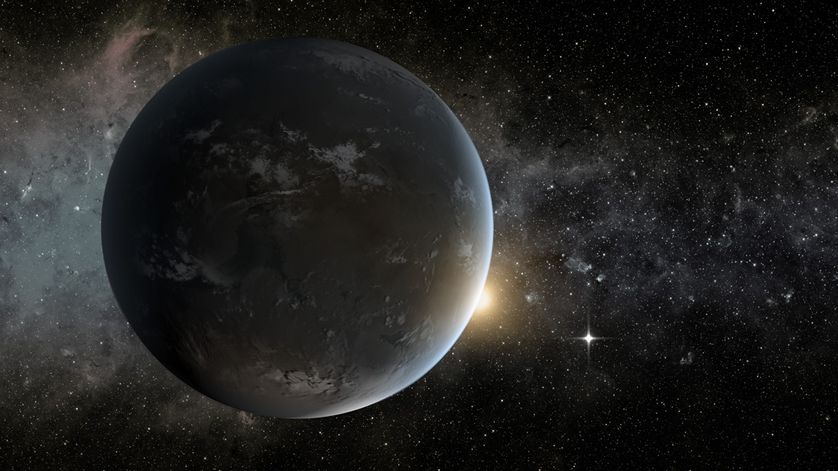
By studying 'snowball' and 'slushball' phases of Earth's history, scientists hope to learn more about other worlds that seem to have frozen oceans, like the exoplanet Kepler-62f. (Illustration: NASA Ames/JPL-Caltech/Tim Pyle)
In fact, Snowball Earth might have been more than just a hardship for those creatures to overcome. There are hints that specific conditions of the Cryogenian might have helped pave the way for the Cambrian Explosion. "The fact that the global freeze occurred before the evolution of complex animals suggests a link between Snowball Earth and animal evolution," Lechte says. "These harsh conditions could have stimulated their diversification into more complex forms."
事实上,雪球地球可能不仅仅是这些生物要克服的困难。有迹象表明,低温期的特定条件可能为寒武纪大爆发铺平了道路。“全球变冷发生在复杂动物进化之前,这一事实表明,雪球地球和动物进化之间存在联系,”莱克特说。“这些严酷的条件本可以刺激它们多样化,形成更复杂的形式。”
"These large and nutritious organisms at the base of the food web provided the burst of energy required for the evolution of complex ecosystems," Brocks said. And it was only in these complex environments, he added, "where increasingly large and complex animals, including humans, could thrive on Earth."
布罗克斯说:“这些位于食物网底部的大型营养生物为复杂生态系统的进化提供了所需的能量。”他补充说,只有在这些复杂的环境中,“包括人类在内的越来越大、越来越复杂的动物才能在地球上茁壮成长。”


















